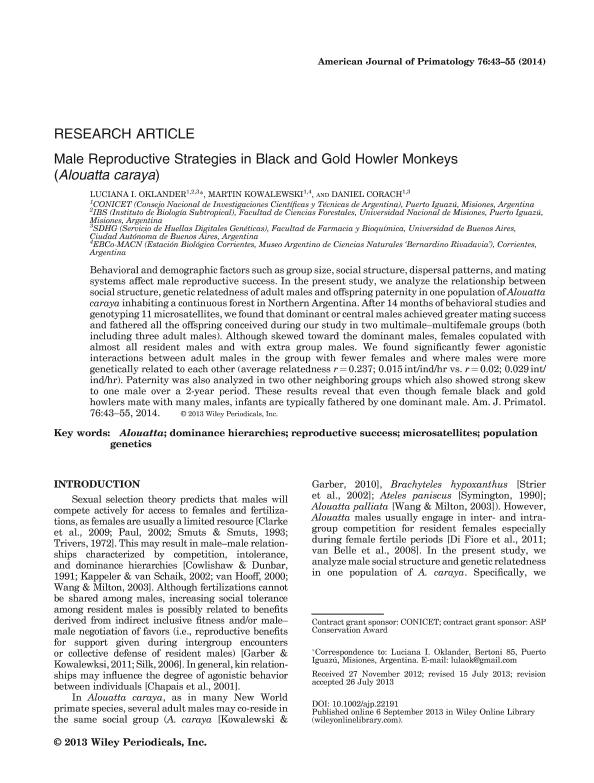Mostrar el registro sencillo del ítem
dc.contributor.author
Oklander, Luciana Inés

dc.contributor.author
Kowalewski, Miguel Martin

dc.contributor.author
Corach, Daniel

dc.date.available
2018-02-19T19:41:45Z
dc.date.issued
2014-01
dc.identifier.citation
Oklander, Luciana Inés; Kowalewski, Miguel Martin; Corach, Daniel; Male Reproductive Strategies in Black and Gold Howler Monkeys (Alouatta caraya); Wiley; American Journal Of Primatology; 76; 1; 1-2014; 43-55
dc.identifier.issn
0275-2565
dc.identifier.uri
http://hdl.handle.net/11336/36760
dc.description.abstract
Behavioral and demographic factors such as group size, social structure, dispersal patterns, and mating systems affect male reproductive success. In the present study, we analyze the relationship between social structure, genetic relatedness of adult males and offspring paternity in one population of Alouatta caraya inhabiting a continuous forest in Northern Argentina. After 14 months of behavioral studies and genotyping 11 microsatellites, we found that dominant or central males achieved greater mating success and fathered all the offspring conceived during our study in two multimale?multifemale groups (both including three adult males). Although skewed toward the dominant males, females copulated with almost all resident males and with extra group males. We found significantly fewer agonistic interactions between adult males in the group with fewer females and where males were more genetically related to each other (average relatedness R-0.237; 0.015 int/ind/hr vs. r-0.02; 0.029 int/ ind/hr). Paternity was also analyzed in two other neighboring groups which also showed strong skew to one male over a 2 year period. These results reveal that even though female black and gold howlers mate with many males, infants are typically fathered by one dominant male. Am. J. Primatol. 76:43-55, 2014.
dc.format
application/pdf
dc.language.iso
eng
dc.publisher
Wiley

dc.rights
info:eu-repo/semantics/openAccess
dc.rights.uri
https://creativecommons.org/licenses/by-nc-sa/2.5/ar/
dc.subject
Hierarchies
dc.subject
Reproductive Success
dc.subject
Microsatellites
dc.subject
Population Genetics
dc.subject.classification
Otras Ciencias Biológicas

dc.subject.classification
Ciencias Biológicas

dc.subject.classification
CIENCIAS NATURALES Y EXACTAS

dc.title
Male Reproductive Strategies in Black and Gold Howler Monkeys (Alouatta caraya)
dc.type
info:eu-repo/semantics/article
dc.type
info:ar-repo/semantics/artículo
dc.type
info:eu-repo/semantics/publishedVersion
dc.date.updated
2017-12-11T15:04:23Z
dc.journal.volume
76
dc.journal.number
1
dc.journal.pagination
43-55
dc.journal.pais
Estados Unidos

dc.journal.ciudad
Hoboken
dc.description.fil
Fil: Oklander, Luciana Inés. Consejo Nacional de Investigaciones Científicas y Técnicas. Centro Científico Tecnológico Conicet - Nordeste. Instituto de Biología Subtropical. Universidad Nacional de Misiones. Instituto de Biología Subtropical; Argentina
dc.description.fil
Fil: Kowalewski, Miguel Martin. Consejo Nacional de Investigaciones Científicas y Técnicas. Oficina de Coordinación Administrativa Parque Centenario. Museo Argentino de Ciencias Naturales ; Argentina
dc.description.fil
Fil: Corach, Daniel. Universidad de Buenos Aires. Facultad de Farmacia y Bioquímica. Servicio de Huellas Digitales Genéticas; Argentina. Consejo Nacional de Investigaciones Científicas y Técnicas; Argentina
dc.journal.title
American Journal Of Primatology

dc.relation.alternativeid
info:eu-repo/semantics/altIdentifier/doi/http://dx.doi.org/10.1002/ajp.22191
dc.relation.alternativeid
info:eu-repo/semantics/altIdentifier/url/http://onlinelibrary.wiley.com/doi/10.1002/ajp.22191/abstract
Archivos asociados
